
The Teloschistaceae are a large family of mostly lichen-forming fungi belonging to the class Lecanoromycetes in the division Ascomycota. Many members of the Teloschistaceae are readily identifiable by their vibrant orange to yellow hue, a result of their frequent anthraquinone content. The presence of these anthraquinone pigments, which confer protection from ultraviolet light, enabled this group to expand from shaded forest habitats to harsher environmental conditions of sunny and arid ecosystems during the Late Cretaceous. Collectively, the family has a cosmopolitan distribution, although members occur predominantly in subtropical and temperate regions. Although most members are lichens that either live on rock or on bark, about 40 species are lichenicolous fungi–meaning they live on other lichens.

Flavoplaca is a genus of crust-like or scaly lichens in the family Teloschistaceae. It has 28 species with a mostly Northern Hemisphere distribution.
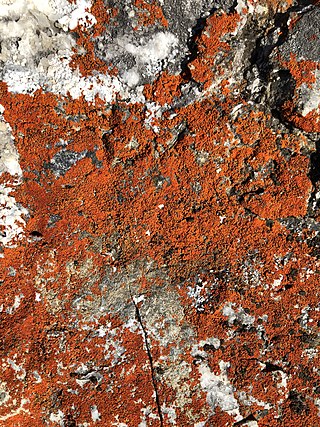
Igneoplaca is a genus in the subfamily Xanthorioideae of the family Teloschistaceae. It contains a single species, the crustose lichen Igneoplaca ignea.
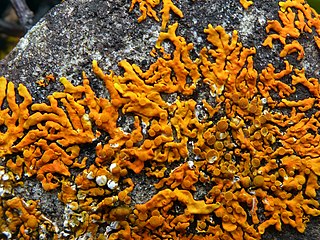
Dufourea is a genus of mostly foliose lichen species in the subfamily Xanthorioideae of the family Teloschistaceae. Species in the genus are mostly found in the Southern Hemisphere.
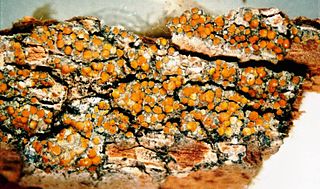
Cerothallia is a genus of crustose lichens in the family Teloschistaceae. It has four species, all of which occur in the Southern Hemisphere. The genus was circumscribed in 2013 by Ulf Arup, Patrik Frödén, and Ulrik Søchting, with Cerothallia luteoalba assigned as the type species. The type is more widely distributed, as it is also found in Europe and North America. The generic name Cerothallia means "with waxy thallus".
Sirenophila is a genus of crustose lichens in the subfamily Teloschistoideae of the family Teloschistaceae. It has four species with an Australasian distribution.
Huneckia is a genus of crustose lichens in the subfamily Caloplacoideae of the family Teloschistaceae. It has four species.
Villophora is a genus of lichen-forming fungi in the subfamily Teloschistoideae of the family Teloschistaceae. It has 9 species. The genus was circumscribed in 2013 by Ulrik Søchting, Ulf Arup, and Patrik Frödén. They assigned Villophora isidioclada as the type, and at that time, only species in the genus. This lichen, previously classified in Caloplaca, is found in South America, Antarctica, and some subantarctic islands. Several additional species were added to the genus in 2021. The generic name Villophora means "carrying filaments".
Shackletonia is a genus of lichen-forming fungi in the family Teloschistaceae, they are lichenicolous, and muscicolous species and known from Antarctica and southern Patagonia.
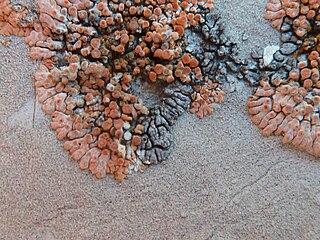
Calogaya arnoldii is a species of saxicolous (rock-dwelling), crustose lichen that is common and widespread in Europe and Asia. It is in the family Teloschistaceae. It was first formally described as a new species in 1876 by Hugh Algernon Weddell, as a species of Lecanora. After being transferred to Caloplaca in 1915, it was considered as a member of that genus for nearly a century. Molecular phylogenetic studies showed Caloplaca to be polyphyletic, and it was divided up into several smaller genera in 2013. Calogaya arnoldii was one of eight species transferred to the newly circumscribed Calogaya by Ulf Arup, Patrik Frödén, and Ulrik Søchting. The lichen is part of a species complex with complicated taxonomy, and in which intermediate phenotypes are frequently observed, making it difficult to reliably distinguish them. Calogaya saxicola is one such similar species, and it has often been confused with C, arnoldii in areas where they co-occur, as the differences between them are subtle.
Catenarina desolata is a species of lichen in the family Teloschistaceae. It was formally described as a new species in 2014 by lichenologists Ulrik Søchting, Majbrit Søgaard, and Arve Elvebakk. It is predominantly found in the southernmost parts of Chile, with some instances in Antarctica and the Kerguelen Islands. Characterised by its dark reddish-brown to almost purple apothecia, this species of lichen was originally thought to be lichenicolous, meaning it grows on other lichens, particularly Aspicilia species. The later discovery non-lichen-dwelling examples from James Ross Island in the Antarctic Peninsula suggests that it is not exclusively lichenicolous. Its distinctive secondary compound, 7-chlorocatenarin, sets it apart from other lichens in the region.
Catenarina vivasiana is a species of crustose lichen in the family Teloschistaceae. It is found in the southernmost regions of South America, predominantly in Chile. Characterised by its dark reddish-brown thallus and unique chemistry, this lichen is named in honour of Spanish lichenologist Mercedes Vivas. It was formally described as a new species in 2014.
Tassiloa is a genus of lichen-forming fungi in the family Teloschistaceae. It has two species.
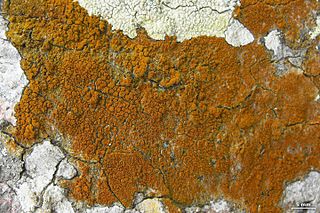
Lacrima is a genus of lichen-forming fungi in the family Teloschistaceae. It has four saxicolous (rock-dwelling), crustose species.
Teuvoahtiana is a genus of lichen-forming fungi in the family Teloschistaceae. It contains three species of saxicolous (rock-dwelling), crustose lichens, all of which occur in South America.
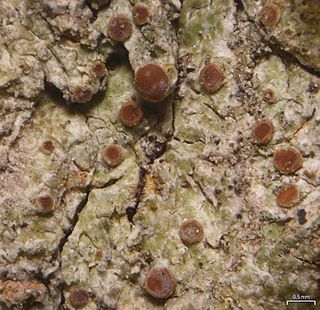
Obscuroplaca is a genus of lichen-forming fungi in the family Teloschistaceae. It contains three species of corticolous (bark-dwelling), crustose lichens.
Gondwania is a genus of lichen-forming fungi in the subfamily Xanthorioideae of the family Teloschistaceae. It has three species. The genus was circumscribed by lichenologists Ulrik Søchting, Patrik Frödén, and Ulf Arup. The type species is G. cribrosa, a species that was first named Polycauliona cribrosa by Auguste-Marie Hue in 1909. The genus name refers to the ancestral supercontinent Gondwana.
Sirenophila gintarasii is a species of lichen in the family Teloschistaceae. Found in Australia, it was formally described as a new species in 2009 by lichenologists Sergey Kondratyuk and Ingvar Kärnefelt, as a member of the genus Caloplaca. The type specimen was collected by the authors from the Camel Rock reserve. There it was found growing on coastal rock outcrops, along with the crustose species Sirenophila eos and Dufourea ligulata, some of which had been deformed by the lichenicolous fungus species Arthonia sytnikii and Pyrenidium actinellum. The species epithet honours Tasmanian lichen lichenologist Gintaras Kantvilas. Ulf Arup and colleagues transferred the taxon to the genus Sirenophila in 2013, following a molecular phylogenetics-based restructuring of the family Teloschistaceae. Sirenophila gintarasii occurs in New South Wales and Victoria.
Marchantiana is a genus of lichen-forming fungi in the family Teloschistaceae. It contains seven species of corticolous (bark-dwelling), crustose lichens that occur in the Southern Hemisphere.
Usnochroma is a genus of lichen-forming fungi in the family Teloschistaceae. It has two species of crustose lichens. The genus was circumscribed in 2013 by lichenologists Ulrik Søchting, Ulf Arup, and Patrik Frödén, with Usnochroma carphineum assigned as the type species. The genus name refers to the yellowish-green colour of the thallus, which is caused by the substance usnic acid. Usnochroma species occur in Macaronesia, South Africa, the Mediterranean Basin, and Algeria.







